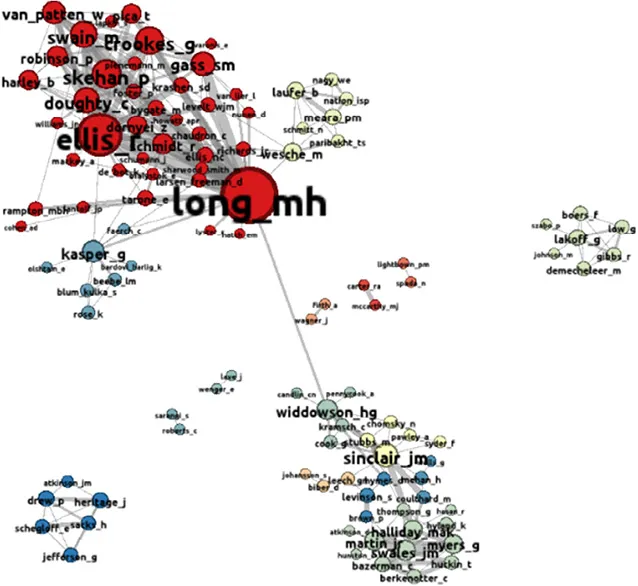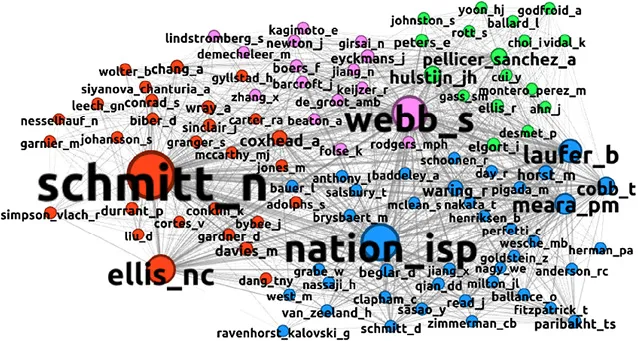![]()
1Introduction
Samuel Barclay and Paweł Szudarski
Research into second language vocabulary acquisition has a long history, with an almost exponential growth in studies of vocabulary learning and teaching over the past few decades. Some features of the field have changed little during this time; a time when Norbert Schmitt, the researcher whose work this volume celebrates, became interested in foreign language teaching. For instance, in 1980, Paul Meara recognised that vocabulary causes language learners considerable difficulty, with learners of all levels claiming vocabulary acquisition to be the source of many of the problems they face (Meara, 1980). In a similar vein, many years later, Webb and Nation stated that learners place a great deal of importance on vocabulary learning and that it is a central aspect of second language competency (Webb & Nation, 2017). Vocabulary was, is and will continue to be a major component of foreign language learning. Other aspects of vocabulary studies, however, have undergone considerable change in this time. Paul Meara began his seminal paper by suggesting that vocabulary acquisition had been largely ignored by the research community (Meara, 1980). The landscape today is remarkably different, with much of the research on vocabulary learning conducted over the past century taking place within the last 20 years (Nation, 2013). Thankfully, vocabulary now receives the kind of research attention that reflects its significance to learners and their development.
Reflecting this rise in popularity, we now have several publications focusing exclusively on vocabulary studies. There are research manuals (Nation & Webb, 2011; Schmitt, 2010), a handbook (Webb, 2020), special editions of journals (e.g. the January 2017 issue of Language Teaching Research, the January 2018 issue of the ITL International Journal of Applied Linguistics, the 2021 issue of Second Language Research) and edited volumes, of which this book is an example. With this rapid increase in research output, it is necessary to take stock of the way in which the field has developed (see McCarthy, this volume). Doing so helps us appreciate that the increasing significance placed on vocabulary learning and teaching is not coincidental, nor is it just a natural function of the importance of the subject matter. Development has occurred because a few key figures have relentlessly championed and evidenced the centrality of vocabulary in second language learning. This volume contributes to the literature on, and explores the growth of, vocabulary studies by celebrating the career of one of these key figures, Norbert Schmitt.
Norbert Schmitt’s Role in the Development of the Field
It is beyond the scope of this introduction to discuss in detail Nobert’s influence on the field of vocabulary studies and the role his research, and that of his doctoral students, has played in creating the space many of us inhabit today; besides, the foreword to this volume has accomplished this so eloquently already. Rather, here we explore his impact on the field with the help of two illustrations (Figures 1.1 and 1.2). These maps, which detail co-citation analysis, have been kindly provided by Paul Meara. Co-citation analysis involves investigating citation patterns to find authors (i.e. nodes) cited together and who are therefore likely to share a similar research focus. It also demonstrates the relative centrality of an author with the betweenness centrality index. This is a measure of how often a node would appear in a path between two random nodes in the network and is indicated by the size of a node.
Figure 1.1 Co-citation analysis of Applied Linguistics from 2000 to 2004. Node size indicates betweenness centrality (see Meara, 2018)
Figure 1.2 Co-citation analysis of The Routledge Handbook of Vocabulary Studies (Webb, 2020)
The first co-citation map (Figure 1.1) is based on papers appearing in the journal Applied Linguistics between 2000 and 2004. This shows that there were several clusters of co-citations but that vocabulary research was still a small and somewhat marginal aspect of the Applied Linguistics enterprise. This is demonstrated by the relative size of the vocabulary cluster and also by the limited number of connections with the other parts of the map. The vocabulary cluster is to the north east of Mike Long, with Norbert between Paul Meara, Mari Wesche and Batia Laufer. Interestingly, a similar analysis today would paint quite a different picture, reflecting the increasingly central position that vocabulary studies occupy within applied linguistics and the many names currently researching it.
In fact, the picture some years later is very different. The second co-citation map (Figure 1.2) illustrates an analysis of the 34 chapters of the recently published The Routledge Handbook of Vocabulary Studies (Webb, 2020). This map indicates the 102 most cited sources in this handbook and the frequency with which each pair of nodes was co-cited. This figure demonstrates that vocabulary studies is now a thriving research community with a considerable number of contributors. It is interesting to note, however, that many of the researchers from the vocabulary cluster in Figure 1.1, including Paul Nation, Paul Meara and Batia Laufer, are similarly central figures of the field today, with one notable addition, Stuart Webb. Another key researcher is Norbert Schmitt, and Figure 1.2 shows just how important Norbert is to the field, revealing that he was cited in every chapter of the book and showing that he was co-cited with every author. Again, the nodes are sized according to their betweenness centrality. The figure demonstrates that Nobert has the highest betweenness centrality score, highlighting not just his importance to the field in general, but the diversity of areas he has explored in his research. Looking at these figures, it is clear that the field has changed dramatically over the past 20 years but that Norbert’s presence has remained constant and developed over the period. It seems only fitting, therefore, that we celebrate his work with this volume.
If we may be permitted a slight diversion at this point, another aspect of Nobert’s career that warrants comment is his championing of early career researchers. One way he has done this is through the Vocabulary Research Group at the University of Nottingham. This was a group of academics and PhD students who met once a week to discuss vocabulary issues. We reviewed papers together, read each other’s work, discussed thorny problems and supported one another in our various research endeavours. This is not to say, however, that the weekly sessions were all sunshine and rainbows. Giving a presentation to the group was famously nerve-racking, with even the briefest of talks provoking a barrage of questions. It was not unusual, for instance, for a 15-minute run-through of a conference presentation to elicit 2 hours of questions. Such thorough interrogation, daunting though it was, not only led to more interesting and robust research projects but also taught the student members about criticality and collaboration and gave us confidence in our work. In many ways, it was an academic internship just as much as it was a studentship.
We have used the past tense to discuss the Vocabulary Research Group because it ceased to meet regularly in 2019, after the last of Norbert’s students, Beatriz González-Fernández (Chapter 2) completed her period of study. However, empowered by their own experiences in the group, many former members have started similar enterprises at their own institutions, building on previous lexical findings, taking research into new and innovative directions and, to borrow Nation and Coxhead’s metaphor of a tree (this volume), using the seeds planted by Norbert to feed further developments within the field. This has led to vocabulary research hubs around the world and an ever-widening academic family: exciting times indeed. In many ways, this volume is a product of the Vocabulary Research Group. The authors of the experimental chapters are largely former members, or students of former members. There are also several collaborations between former students, some who did not even study at the same time but who are connected by their shared experience of the group, Sonbul and Macis (Chapter 10) being a case in point. The volume shows the extent to which ripples caused by one academic can be maintained many years later and likewise cause ripples of their own. All the authors of the experimental chapters of this volume, in one way or another, can trace their development back to the Vocabulary Research Group. It is fair to say that we all learnt a great deal from attending those meetings in CRAL Meeting Room 1 in the Trent Building, University of Nottingham (evidence of which can be seen on Norbert’s website: www.norbertschmitt.co.uk).
Goals and Structure of the Volume
The central aim of this volume is to contribute to the growing literature on vocabulary studies and to inspire future research endeavours in this area. It takes the career of Norbert Schmitt as a framework, dividing the chapters into sections that represent the focus of much of his research contribution: theory and assessment, formu...


